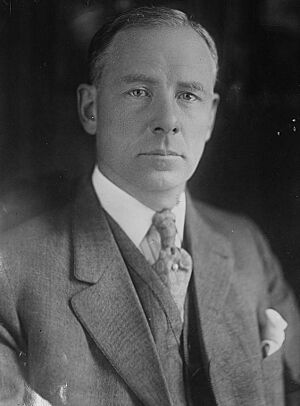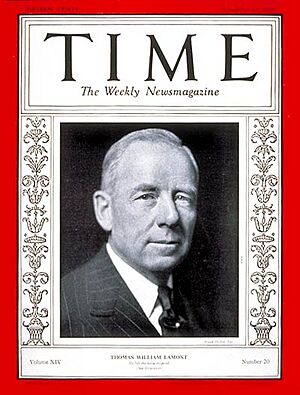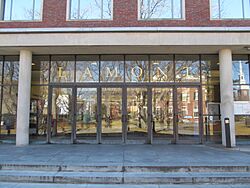Thomas W. Lamont facts for kids
Quick facts for kids
Thomas W. Lamont
|
|
|---|---|

Lamont circa 1918
|
|
| Born |
Thomas William Lamont Jr.
September 30, 1870 Claverack, New York, U.S.
|
| Died | February 2, 1948 (aged 77) Boca Grande, Florida, U.S.
|
| Education | Phillips Exeter Academy Harvard University |
| Occupation | Banker |
| Years active | 1903–1947 |
| Employer | J.P. Morgan & Co. |
| Board member of | International Committee of Bankers on Mexico |
| Spouse(s) | Florence Haskell (Corliss) Lamont |
| Children | Corliss Lamont, Thomas Stilwell Lamont |
Thomas William Lamont Jr. (September 30, 1870 – February 2, 1948) was an American banker. He became a very important figure in the world of finance.
Contents
Early Life and Education
Thomas Lamont was born in Claverack, New York. His father was a Methodist minister, so his family moved often. They were not very rich.
He went to Phillips Exeter Academy and finished in 1888. While there, he was busy with the school newspaper, The Exonian, and other school publications. After Exeter, he attended Harvard College.
Starting His Career
At Harvard, Thomas became the first freshman editor for The Harvard Crimson newspaper. This job helped him pay for some of his college costs. He graduated from Harvard in 1892.
After college, he started working for the New York Tribune newspaper. He also worked for other newspapers like the Albany Evening Journal and the Boston Herald. He learned a lot about the financial world by helping the financial editor at the Tribune.
Because newspaper jobs did not pay much, he decided to switch to business.
Moving into Business
Thomas Lamont joined a company called Cushman Bros. He helped turn it into a very successful business that imported and marketed products. This company later became Lamont, Corliss, and Company. He worked with his brother-in-law, Corliss, to make the company strong.
His skills in business caught the eye of Henry P. Davison, a well-known banker. Davison asked Thomas to join a new bank called Bankers Trust. Thomas started as a secretary and treasurer, then became Vice President and later a director. He also became Vice President of the First National Bank.
In 1918, Thomas bought the New York Evening Post newspaper. However, it did not make a profit, so he sold it in 1922.
Joining J.P. Morgan & Co.
On January 1, 1911, Thomas Lamont became a partner at J.P. Morgan & Co.. This was a very powerful and famous banking firm.
World War I Efforts
During World War I, J.P. Morgan & Co. helped the Allied countries buy supplies. In 1917, Thomas joined the Liberty Loan Committee. This group helped the U.S. government sell war bonds to Americans to fund the war.
He also advised a special mission to the Allies, requested by President Woodrow Wilson. Thomas traveled to Europe to offer advice. He even tried to convince America to help the Bolsheviks in Russia. This was so Russia would stay in the war, but his efforts were not successful.
Peace Talks After the War
After World War I, Thomas Lamont helped decide what Germany would have to pay in war damages. He was part of committees that created the 1924 Dawes Plan and the 1929 Young Plan. These plans aimed to reduce the amount Germany had to pay.
A Voice for J.P. Morgan
Between the two World Wars, Thomas Lamont became a main spokesperson for J.P. Morgan & Co. He handled the press and defended the company during important hearings. He was also a key person for Morgan's investments in other countries.
He advised U.S. Presidents like Woodrow Wilson, Herbert Hoover, and Franklin Roosevelt. For example, President Hoover talked to Lamont about a plan to pause debt payments during the 1931 financial crisis. In 1932, Thomas Lamont was chosen to be a member of both the American Academy of Arts and Sciences and the American Philosophical Society.
Dealing with Japan
In 1920, Lamont went on a special trip to Japan. His goal was to protect American financial interests in Asia. He supported Japan's peaceful policies for a long time.
However, some people later claimed that Lamont helped Japan hide its actions during the Mukden incident. This event was used by Japan as an excuse to invade Manchuria. This went against what the U.S. government and the League of Nations believed.
Work with Mexico and Italy
Thomas Lamont led the International Committee of Bankers on Mexico. He successfully worked out an agreement called the De la Huerta-Lamont Treaty about Mexico's foreign debt. He continued to lead this committee into the 1940s.
In 1926, Lamont helped Italy get a large loan of $100 million. He had supported Italian fascism early on. However, he thought the Second Italo-Abyssinian War in 1935 was wrong.
The Wall Street Crash of 1929
On Black Thursday in 1929, Thomas Lamont was in charge of J.P. Morgan & Co. President Herbert Hoover had warned Lamont about problems in the stock market. Lamont told the President not to worry, saying "The future appears brilliant!"
However, the market crashed the next Thursday. Lamont tried to stop the panic by getting Wall Street firms to buy many stocks. This effort did not work, and stocks lost a lot of their value.
Becoming Chairman
In 1943, J.P. Morgan & Co. was reorganized. After J.P. Morgan Jr. passed away, Thomas Lamont was chosen as the chairman of the board of directors. He was the first person not from the Morgan family to lead the bank since George Peabody.
Giving Back to the Community
Once he became wealthy, Thomas Lamont gave a lot of money to Harvard and Exeter. He helped pay for the building of Lamont Library at Harvard. After World War II, he made a big donation to help restore Canterbury Cathedral in England.
His wife, Florence Haskell Corliss, gave their weekend home, Torrey Cliff, to Columbia University. This place is now the Lamont–Doherty Earth Observatory. After Florence passed away, a special fund was set up to create the Lamont Poetry Prize.
Later Life and Family
Thomas Lamont passed away in Boca Grande, Florida, in 1948.
In 1895, he married Florence Haskell Corliss. Florence graduated from Smith College and earned a master's degree from Columbia University. Thomas and Florence had four children. Their son, Corliss Lamont, became a philosophy professor. Another son, Thomas Stilwell Lamont, later became a vice-chairman at Morgan Guaranty Trust.
One of his grandsons, Lansing Lamont, was a reporter for Time. He wrote books about important events he covered. Another grandson, Thomas William Lamont II, served in the submarine service and died when his submarine sank in 1945.
One of his great-grandsons, Ned Lamont, was elected governor of Connecticut in 2018.
Writings by Thomas Lamont
- Henry P. Davison; the record of a useful life Harper & Brothers, New York and London, 1933. ISBN: 1176084445
- My boyhood in a parsonage, some brief sketches of American life toward the close of the last century Harper & Brothers, New York and London, 1946.
- Across world frontiers, Harcort Brace & Co., New York, 1951. ISBN: 1258302160
More Information
- Thomas W. Lamont papers at Baker Library Special Collections, Harvard Business School.
- Lamont-Corliss Family Papers, [1], Smith College.



